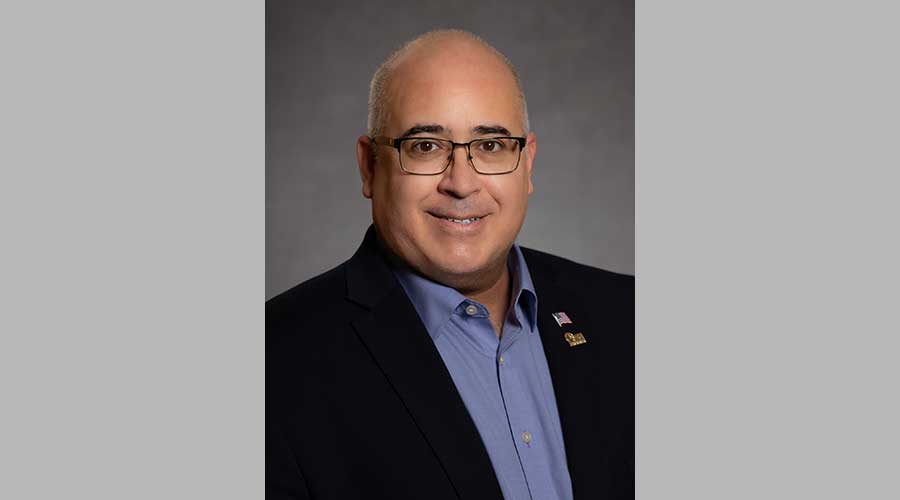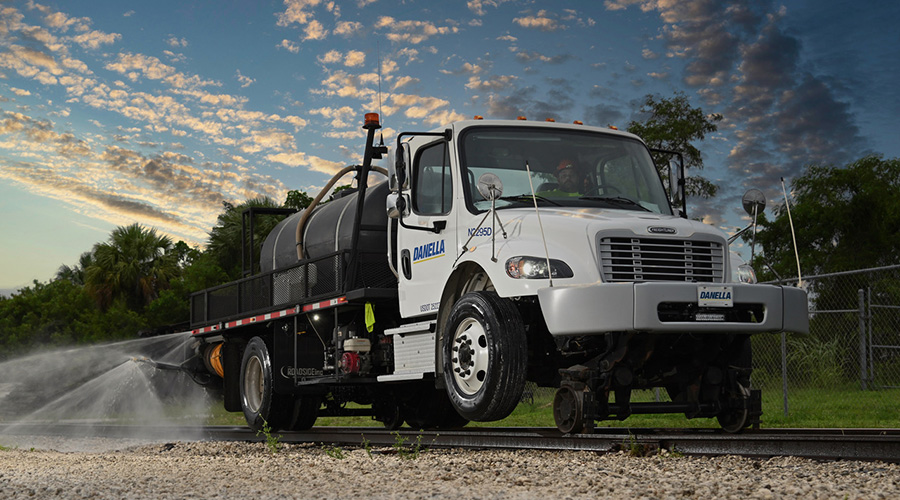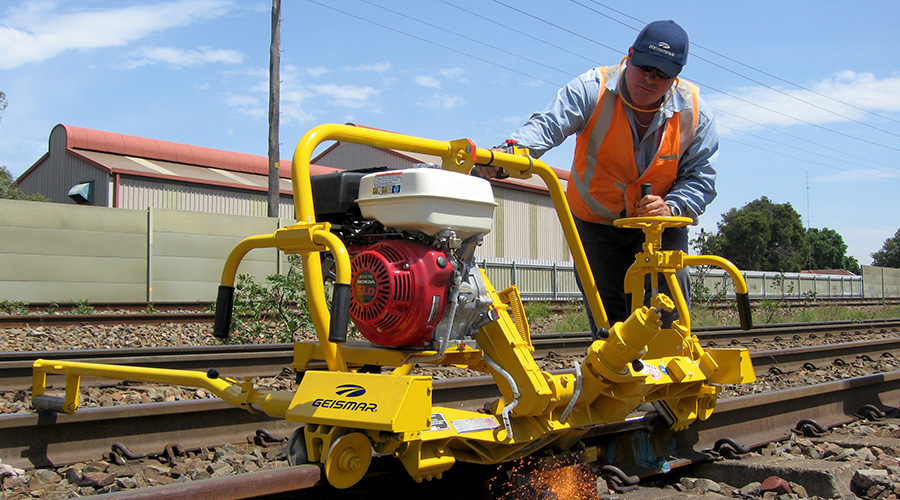Stay updated on news, articles and information for the rail industry
May 2013
Rail News: MOW
Railroad ballast maintenance equipment update
— by Mary Turner
Mark Twain proclaimed that “a railroad is like a lie. You have to keep building it to make it stand.” And ballast, which bears the load, facilitates adequate drainage and smothers unwanted vegetation, is the foundation of that stance. Accordingly, railroads invest considerable time and money on ballast maintenance. Their investment options range from ballast saving and recycling technology to spreader ditchers and ballast trains to ballast regulators and cleaners to track lifters and undercutters, plus an array of trackbed and tracksite investigation tools. For a bit more detail on some of these offerings, Progressive Railroading contacted a dozen ballast maintenance equipment suppliers. Responses from 10 of them follow.
Balfour Beatty Rail Inc.
Balfour Beatty Rail Inc. and United Kingdom-based partner Zetica offer a suite of geophysical and geotechnical solutions for trackbed and trackside site investigation and monitoring.
"The tools can measure trackbed and embankment stiffness by using surface wave seismics," Balfour Beatty Rail officials said in an email. "The technology also uses electrical resistivity imaging measurements to characterize material change and water ingress beyond the range of other tools — including GPR [ground penetrating radar] and various solutions that monitor slope and trackbed settlement."
The tools can be used to manage the impact of ballast pockets or drainage problems identified by GPR surveys.
As part of Balfour Beatty Rail's Rail Asset Scanning Car (RASC) services, the company will upgrade its fleet of hi-rail inspection vehicles with dual-frequency GPR systems. Combined with post processing and existing inertial spatial positioning systems, the GPR systems help provide decimeter survey location accuracy.
"We also offer customers accurate mapping of their railroad assets by combining new stereo camera technology with exiting ground penetrating radar systems," Balfour Beatty Rail officials said. "This technology can map trackside equipment, mile posts and trackbed features that include the start and end of turnouts, switches, road crossings, mud spots and other features within the confines of the trackbed surface. These improvements provide a cost-effective solution for asset inspection and geo-referencing of [a customer's] assets."
On the research and development front, the Balfour Beatty Rail/Zetica team has a number of initiatives in progress designed to "improve the use of radar technology within the railroad environment," Balfour Beatty Rail officials said. Witness the trial of a new high-speed, two-dimensional laser profiler fitted to Balfour Beatty Rail's hi-rail GPR inspection vehicles, which combine GPR with surface profile measurement of the trackbed. The combined technologies produce a three-dimensional image of the trackbed. Engineers and managers can use information derived from this process "in the MOW decision-making process, including budget allocation," company officials said.
Meanwhile, recent enhancements of Zetica's train-mounted Advanced Rail Radar systems include a new graphical user interface. The GPR systems "interface seamlessly" with existing gage restraint measurement, track geometry and positioning systems to provide clients with a fully integrated track inspection solution for trackbed and ballast inspection, the company said.
Georgetown Rail Equipment Co.
An adequate ballast section serves several essential functions, including distribution of vertical load from the bottom of the tie to the top of the subgrade, providing lateral and longitudinal restraint for the tie and track superstructure, Georgetown Rail Equipment Co. (GREX) officials said in an email. Proper ballast allows for correction of track geometry variations, facilitates drainage, and provides track resiliency and damping for noise, vibration and dynamic impact.
Accordingly, ballast assessment, quantification and delivery continue to evolve with recent advancements in inspection technology.
"GREX continues to advance BallastSaver inspection technology to calculate ballast deficiencies in support of our automated GateSync ballast delivery system," said Greg Grissom, vice president-engineering, in an email.
BallastSaver optimizes ballast placement by calculating ballast requirements ahead of the ballast delivery, resulting in accurate distribution, orientation and placement of the resource, he added.
"Our recent R&D advancements have been focused on moving these successes toward system ballast prioritization, where technology advancements can empower railroads with information to optimize and 'right size' their ballast planning initiatives," Grissom said.
In March, GREX tested the BallastSaver system at the Transportation Technology Center Inc. in Pueblo, Colo. Test locations were "substantially modified" with displaced ballast while defined shapes of known volumes were inserted in place, GREX officials said. Crib ballast also was removed randomly to create an assessment of shoulder and crib functionality. An additional test to evaluate the "end of tie" defect functionality also was conducted. During this test, prescribed ballast amounts were removed from the end of tie at specific lengths to evaluate the detection capability of the defect, which could indicate examples of lateral track instability.
And with research support from Dr. Allan Zarembski at the University of Delaware, GREX has developed a new prioritization algorithm that enables railroads to determine the relative importance of any missing ballast sections and plan the ballast placement process as part of an overall track maintenance program. The research advances the notion that "not all ballast needs are created equal" and prioritizes deficiencies based on numerous track characteristics, Grissom said.
"Inspection technologies can now tell us where we are deficient or fouled within the ballast section, but comparatively how does one area obtain priority over the next?" he added. "We have put some good science behind exploring all of these factors and look forward to sharing those results at Railway Interchange 2013." [Editor's note: Railway Interchange 2013 will be held Sept. 29 - Oct. 2, 2013, in Indianapolis.]
Harsco Rail
Harsco Rail recently updated its Spreader Ditcher machine and will complete orders for new machines this year, company officials said in an email. Originally designed in the 1960s, the Harsco Spreader Ditcher has been updated to meet current market requirements.
Pushed by one or multiple locomotives, the Harsco Spreader Ditcher is used to plow heavy snow, spread ballast and cut trackside ditches. The 160,000-pound, 53-foot-long ditcher is equipped with an operator control cab, front plow, side wings, two non-powered bogies, AAR couplers and an APU for electrical/hydraulic power.
"Railroads primarily use the Spreader Ditcher to reduce the time it takes to clear or re-profile their ballasted tracks," Harsco Rail officials said. "The machine is able to cut fouled ballast from the end of ties and plow clean ballast on the track."
The Spreader Ditcher helps move the ballast to produce the correct track roadbed section. It also plows in center, right or left-hand directions while retrieving ballast deposited outside the toe line. The latest version includes an array of new features and options, such as in-cab locomotive controls, hydraulic locks, insulated walkways, heated windows, train line air brake controls and egress safety windows.
"With these updated machines, the railroad will not only fend off snow and ice, but also achieve benefits in ballast spreading and ditching efforts," Harsco Rail officials said.
Herzog Railroad Services Inc.
Herzog Railroad Services Inc.'s (HRSI) GPS Ballast Train fleet has been "a work in progress since we began R&D on the first one," HRSI officials said in an email. Advancements in circuit boards, flow sensors, SMART Cylinders development, center dump capability and new ballast dumping programs all are part of the enhancements that make up "the SMART Train," which is now capable of dumping up to 30 cars per mile on concrete skeletonized track at 6 mph, company officials said.
"The SMART Cylinders allow us to monitor each door so we know when they open and when they close, as well as giving us the ability to center dump the ballast," they said. "Flow sensors give us the ability to identify whether or not the ballast is actually being dumped from the car. If material flow is not detected, then the door closes and another car's door opens. This allows us to reduce potential for cars to become off balance and eliminates skips in the ballast spread."
SMART/P.L.U.S. Trains can be set up quickly; an entire 75-car train can be dumped in about 30 minutes.
Accuracy and the ability to dump ballast close to fixed points also means "less time spent pushing and pulling material with surfacing gangs, saving money in train delay and labor costs," HRSI officials said.
The company also offers the ProScan LIDAR Truck. Before every dump, HRSI must conduct a survey to confirm that fixed points are properly marked. The railroad then informs HRSI how many cars of ballast per mile are scheduled for a particular project. The ProScan LIDAR Truck "removes the subjectivity and human error that may play into the process," HRSI officials said.
The ProScan LIDAR truck can survey the track at maximum hi-rail truck speed and scan up to 120,000 points per second. The surface scan generated is used to determine the amount of ballast needed based on a railroad-provided template. A seamless survey can be provided through tunnels, areas of thick vegetation and mountainous regions.
"The survey accuracy of the ProScan LIDAR Truck is also beneficial to the final product ballast spread," company officials said. "Those surveys increase our ability to dump closer to fixed locations. HRSI Ballast Trains can dump within 10 feet on the approach and five feet on the departure of fixed locations."
Knox Kershaw Inc.
The Knox Kershaw Inc. KBR 925 ballast regulator now sports a larger, more spacious cab with seating for up to four people. It also is equipped with CAN Bus joysticks and a large LCD screen to provide instant feedback on machine diagnostics and troubleshooting, the company said in an email.
For improved safety and ease of maintenance, the KBR 925 now features an "easily accessible Visionaire side-mounted hydraulic-drive air conditioner," company officials said.
And the new brushcutter option — which company officials said has been "extremely popular" since its introduction in early 2013 — adds a new dimension to the Knox Kershaw ballast regulator. It addresses two important maintenance tasks with one machine: ballast maintenance and brush control, they said.
Loram Maintenance of Way Inc.
Loram Maintenance of Way Inc. officials continue to develop the company's Track Lifter Undercutter (TLU) Series, which "provides a more productive and cost-effective alternative to traditional undercutting services," Loram officials said in an email. New TLU features include track positioning, an improved sledding blade and a tie-pad replacement module.
"These enhancements increase versatility of the machine and provide added customer benefits," Loram officials said.
Meanwhile, demand from Class Is and international railroads for Loram's High Performance (HP) Shoulder Ballast Cleaners continues to grow; the Badger Ditcher, too, is experiencing "steady and consistent growth," company officials said. The Ditcher is designed to provide economical, high-production solutions to drainage problems, such as ballast-filled ditches and slope erosion.
"Railroads are seeing substantial long-term cost savings associated with well-established drainage and ballast maintenance programs," said Brad Willems, director of marketing and product development.
Customers also continue to embrace Loram's Railvac, which can remove fouled ballast and debris from tunnels, clean and install drain tiles and culverts, and cross-trench for cables and pipes without taking track out of service, company officials said. The Railvac also removes ballast from bridge decks and grade crossings without removing ties or rail, undercuts switches and mud spots, and removes contaminated material from yards and stations.
Railroads are not only demanding high production, they are seeking out new ways to be safer and more environmentally conscious. The HP Shoulder Ballast Cleaners, Badger Ditcher and Track Lifter Undercutter all can achieve "industry-leading fuel efficiency and corresponding low emissions with integrated auxiliary generators," Loram officials said. HP Shoulder Ballast Cleaners now incorporate a safety feature designed to help prevent wayside damage caused by the swing conveyor. The feature disables the machine's travel system upon detection of an un-commanded conveyor movement.
Loram's customers are in preventative maintenance mode, so they aren't just focusing on "problematic" areas when it comes to ballast, which lowers overall costs, increases traffic throughput and provides more return on their investment, Loram officials said. Customers also are coordinating equipment with system work gangs during major track outages, which enables Loram to provide "optimal production and reduce lower overall cost for the customers," company officials said.
Miner Enterprises Inc.
Miner Enterprises Inc. recently improved the performance/life cycle of the linear actuators and electrical systems used in its Miner Electric AggreGate®, a stand-alone electric aggregate system.
The electric stand-alone AggreGate enables independent operation of the car from anywhere within a ballast train, eliminating the need for grouping manual and automatic cars.
"Miner's Aggregate has a reputation in North America as a robust and effective system for unloading ballast," Miner officials said in an email. "That reputation now extends to international markets, including South America. In the last few years, hundreds of air powered Aggregates have been successfully utilized on railroads in Brazil and Columbia."
Meanwhile, the company is developing a ballast plowing system to add to existing ballast cars. The plow system will use the Miner AggreGate power supply system, including electric, hydraulic and pneumatic. A manual version of the plow can be applied to any ballast car.
"Railroads have been asking for a safe, durable, maintenance-free way to ballast that can be applied to new or existing cars, and our Plow and AggreGate product meets these needs," Miner officials said.
Nordco Inc.
Nordco Inc. recently expanded its machine and parts rebuild capabilities for production tampers.
"We are able to completely rebuild and upgrade virtually any production or switch tamper on the market," said Bill Straub, president of equipment services, in an email. "In addition, we now carry an extensive line of Jackson 6700 rebuilt parts and components, and we continue to expand our offerings each month."
Railroads are searching for ways to expand the useful life of their maintenance-of-way assets, he added.
"The opportunity to completely rebuild, essentially creating a new asset for a fraction of the cost of a new machine, is key to achieving this goal," Straub said. "Our continuing emphasis on expanding our rebuild business is designed to meet this cost-saving need."
Plasser American Corp.
A new development from Plasser American Corp. and Theurer is the RM 900 VB, a high-capacity ballast cleaning machine that reuses ballast. The machine is fitted with "all the necessary work units" for ballast recycling, ballast cleaning and full excavation, with the option of supplying new ballast, company officials said in an email.
The RM 900 VB incorporates multiple work systems designed to enhance cost-efficient ballast cleaning, including a primary ballast screening unit and a crushing plant to sharpen ballast edges for recycling.
Additional features include an undercutting/excavating chain, a high-performance eccentric screening unit with a dust suppression system, two dynamic track stabilizing units designed to ensure initial track geometry quality and a sweeper unit. The latter sweeps the tires and can pick up surplus ballast for redistribution, compensating for any shortage of ballast at the worksite, company officials said.
Plasser also offers other ballast equipment, including the RM 95-800 W, which is equipped with an impact crusher to sharpen reusable ballast, and a ballast washing unit; the Unimat 09-475/4S N-Dynamic, which the company said is the world's first "all in one" tamping machine for switches and plain track; and the BDS-2000 ballast distribution system, which, while in the process of ballast profiling, picks up surplus ballast and stores it.
Progress Rail Services
Progress Rail Services' newest shoulder ballast cleaner is the KSC2000, which features a single shaker screen design capable of cleaning 2,900 tons of ballast per hour.
The KSC2000 can bypass the screen and ballast return system; the spoils conveyor can deposit spoils away from the track centerline or into a towed rail car, Progress Rail Services officials said in an email.
The shaker screen elevates and tilts to accommodate varying track conditions, and the large ballast hopper provides ample ballast storage, officials added.
Adjustable ballast plows, full ballast regulator style wings and tie end brooms complete the operation.
The KSC2000's main power supply is a Caterpillar C32 Tier IV engine; single and three-phase AC electrical power is supplied by a Caterpillar 45kW generator set.
An optional backup generator/compressor/welder unit provides additional redundancy. Onboard fuel capacity is 1,500 gallons with built-in transfer piping for use with a towed fuel car. The KSC2000's maximum travel speed is 30 mph with a work speed of 4 mph.
Progress Rail Services also offers a newly designed TCDD Ballast Regulator and recently shipped "multiple units" to the Turkish State Railways, company officials said. The single-pass regulators feature forward mounted wings and a center mounted X-plow system. The single pass is completed with a rearward sweeping broom and deflector system. For ballast collection, the five-cubic-meter hopper can be loaded via the rear boom and elevator conveyor system. TCDD Ballast Regulators are powered by Caterpillar C9 Tier III 350 horsepower engines. The maximum travel speed is 100 kph.
The company also recently introduced the 4600 Ballast Regulator, which features a cab-forward design that offers improved visibility of the plow and side wing operations, company officials said.
Powered by a Caterpillar C7 Tier III 250 horsepower engine, the 4600 features a standard two-speed, shift-on-the-go transmission and 28-inch wheels, which provide excess traction power for demanding ballast regulating conditions, the company said.
The ballast regulator also features a forward-mounted transmission, pump access ports and easy-to-access valves. Multiple attachments are available for plow, wing and boom operations.
In addition, the company continues to develop international ballast regulator, sand fighter, non-standard rail gauge regulator and yard cleaner designs, company officials said.
Mary Turner is a Genesee Depot, Wis.-based freelance writer. Email comments or questions to prograil@tradepress.com.
Keywords
Browse articles on ballast ballast maintenance ballast management ballast equipment Balfour Beatty Rail Georgetown Rail Equipment Harsco Rail Herzog Railroad Services Knox Kershaw Loram Maintenance of Way Miner Enterprises Nordco Plasser American Theurer Progress Rail ServicesContact Progressive Railroading editorial staff.


 2025 MOW Spending Report: Passenger-rail programs
2025 MOW Spending Report: Passenger-rail programs
 Gardner steps down as Amtrak CEO
Gardner steps down as Amtrak CEO
 Guest comment: Oliver Wyman’s David Hunt
Guest comment: Oliver Wyman’s David Hunt
 Women of Influence in Rail eBook
Women of Influence in Rail eBook
 railPrime
railPrime







